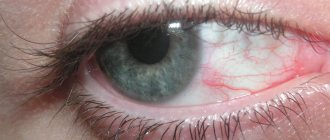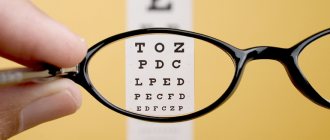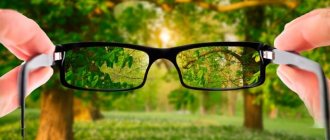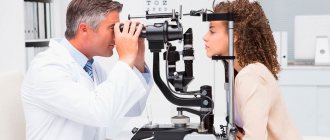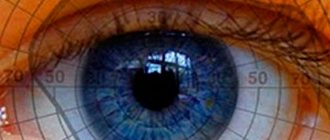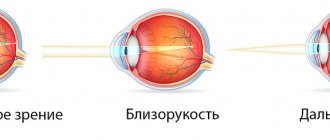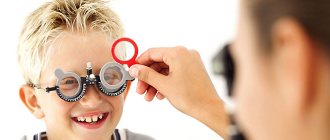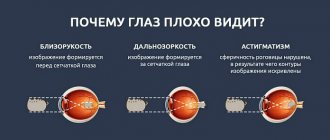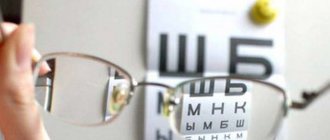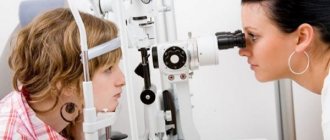Myopia is a vision disorder that causes great discomfort. A person sees well only what is close to him. Everything that is in the distance is presented in a fuzzy blurry form. Therefore, the urgent question is: how to treat myopia. Modern medicine makes it possible to cure vision even without surgery. There are various methods that will help you heal your eyes quickly and you will get 100% vision.
In the article you will get acquainted with alternative methods of treating myopia, which are offered by both traditional and alternative medicine. We present to your attention special exercises that can be done at home.
Who is destined for
But it’s not only excellent students who sit staring at books every day who lose their sight. Ophthalmologists say that by looking into the eyes of a newborn, you can already predict whether he is at risk of myopia or not.
● The risk group primarily includes children of myopic parents. Moreover, if both the father and mother have myopia, the likelihood that the child will develop it is very high. Apparently they all have weak connective tissue in their family. This feature is manifested by flat feet, stooping, and myopia.
● Candidates for glasses are premature babies.
● Those who often suffer from acute respiratory infections, flu, pneumonia, and who suffer from allergies. Due to illness, their metabolism and blood supply to the eyes are disrupted, the structure of the sclera changes, it becomes pliable, under visual stress it stretches and does not return the apple to its original shape.
Why treat if you can't cure?
Myopia cannot be cured. Everyone knows this. But when children’s vision begins to deteriorate, it may also be the so-called false myopia: just a weakening of the ciliary muscle. False myopia can be cured. This is why it is so important to have your children's vision checked regularly.
But even if irreversible myopia has already begun, its development can be stopped so that vision does not deteriorate quickly.
Now there are good methods for treating myopia. This includes far and near accommodation training with special glasses, magnetic therapy, laser treatment, pneumomassage - special glasses that massage the eyes and improve the performance of the ciliary muscle, and physiotherapy. Today, myopia is also treated with a modern type of reflexology – electropuncture. Reflexology is an effect on those points of the skin of the body that are associated with the organ of vision. Only in classical reflexology, which was known to doctors 5 thousand years ago, the points are exposed to needles or burned with wormwood cigars, and in electropuncture - with microdoses of current. It is not painful or scary, which is very important when treating children, and such treatment cannot harm the patient.
This technique not only treats the eyes, but also heals the entire body, which is very important in the treatment of near-handedness.
Vision correction
There are optical (use of glasses and contact lenses) and laser vision correction.
All correction methods are aimed at changing the optical system of the eye, which ensures the formation of images on the retina.
In our clinic, the selection of glasses and contact lenses is carried out by a professional optometrist based on diagnostic data, which guarantees optimal compliance with the individual characteristics of the eye. Opticians will not be able to determine the cause of the disease and, therefore, prescribe the correct treatment.
Optic Center also offers orthokeratology, a unique method that uses night lenses. During sleep, they temporarily change the shape of the cornea, which allows you to do without lenses and glasses during the day.
Laser vision correction in our clinic is carried out using LASIK and photorefractive keratectomy (PRK). During surgery, the shape of the cornea is changed using a laser beam, which leads to the elimination of pathology. Laser correction is the fastest and most effective way to correct vision. In most cases, the operation allows you to achieve 100% results, which last forever.
Gymnastics for tired eyes
Teach your child to do eye exercises and massage every day between classes to relieve visual fatigue.
The massage is simple and pleasant. It improves blood circulation and normalizes eye pressure.
We move the lateral surfaces of our thumbs from the wings of the nose to the corners of the eyes and, without lifting our hands, to the beginning of the eyebrows and along the eyebrows to their end - 18 times.
We massage the eyeballs through the eyelids from the outer corners of the eyes to the inner ones, pressing lightly - 18 times.
For gymnastics, you need to make a mark with a diameter of 3 mm on the window glass at eye level with a felt-tip pen. Move 35 cm away from the window and look at the mark for 5 seconds, and at the view outside the window for 5 seconds. And so on for 3-5 minutes. Anyone who is prescribed glasses does this gymnastics with glasses on. This is a workout for the eye muscle.
Hardware methods
The Optic-Center has special “Vision Protection Rooms” where you can undergo hardware procedures that combine the effects of physiotherapy and eye gymnastics:
- ESOM – ophthalmic electrical stimulator;
- MOLE - infrared rays affect biologically active points, which not only corrects vision, but also activates the body's defenses;
- VIZOTRONIK is the best option for those who do not have the patience to do eye exercises;
- accommodation according to Dashevsky - the ciliary muscle, which provides accommodation of the eye, is trained.
Eye trainers will help correct visual acuity and avoid surgical intervention.
Point of view
Whether your child will have myopia or not depends more on his lifestyle than on heredity, according to Australian scientists. They analyzed data from 40 studies of doctors from different countries and found that, for example, 70% of young people of Indian origin living in Singapore suffer from myopia, and in India there are no more than 10% of the same, because the visual load of these Indians varies greatly. Among boys 14-18 years old who study in religious schools in Israel, where a lot of time is spent reading religious texts, 80% are myopic, while in ordinary public schools in this state the figure is 30%.
By the way
A common misconception. Many parents believe that the glasses prescribed by the child’s doctor do not need to be worn at the very beginning of the development of myopia. Let the eye supposedly train itself when it looks into the distance.
In fact, glasses correction does not harm vision. On the contrary, when a child squints all the time, straining his eyes because he sees poorly, his myopia progresses faster. If the doctor has given permission to read and write without glasses, but has prescribed them for distance use, glasses must be worn when you look at the school board, when you go to the theater, and when you sit in front of the TV.
Progressive myopia
With rapidly developing myopia (myopia), a person’s visual acuity deteriorates by more than one diopter every year. This phenomenon is most often diagnosed in schoolchildren and students - young people have rapidly growing bodies, including their eyes, and they also experience significant visual stress. The pathology is characterized by elongation of the eyeball, deterioration of nutrition of the tissues of the eye structures, ruptures and detachments of the retina, and clouding of the vitreous body.
Patients with progressive myopia are not recommended to lift heavy weights or engage in active sports, since sudden movements contribute to destructive processes in the eye. Progressive myopia leads to irreversible consequences in the central zone of the retina, which, in turn, leads to severe deterioration of vision.
How to stop the progression of the disease
The most effective are four directions that stop the development of myopia in patients of any age.
- Contact or spectacle correction. One of the most accessible and simple methods to stop the progression of the disease. When selecting glasses or contact lenses, the patient’s lifestyle is taken into account - how much time he spends at the computer, TV or books, how often he looks into the distance. In some cases, two glasses may be prescribed - for distance and near.
- Hardware treatment. With the help of devices, children and adolescents undergo therapeutic courses. The equipment allows not only to smooth out the consequences of myopia, but also other pathologies, for example, strabismus, spasm of accommodation, amblyopia, asthenopia.
- Conservative treatment and gymnastics. The combination of eye exercises and taking eye medications improves the condition of the eye structures, increases accommodative potential and, accordingly, visual acuity. The action of medications in this group is aimed at improving microcirculation of the eyeball, dilating the pupil, stimulating the retina and ciliary muscle.
- Laser coagulation of the retina. When peripheral dystrophies and retinal tears are detected, the latter is strengthened using laser coagulation. Due to the effect of the laser beam on the retina, coagulation and fusion occurs between the choroid and retina of the eye, which reduces the risk of developing retinal detachment in the future.
It is dangerous to leave progressive myopia to chance: with such a diagnosis, you need to be regularly examined by an ophthalmologist.
If this is not done, irreversible changes in the retina and vision impairment may occur. Fomenko Natalia Ivanovna
Interesting
How our eye works. The eyeball, when we look at a nearby object, stretches out, and when we look into the distance, it returns to its original round shape. Then the image is focused on the retina all the time, regardless of whether it is located far from the eye or close. But in some people the sclera - the membrane that covers the eyeball like a stocking - is weak, and over time it ceases to return the eyeball to its round shape. Now a distant image does not focus accurately on the retina, and a person sees things that are farther away blurred.
What is myopia
Myopia Nearsightedness is a condition in which a person has difficulty seeing objects located in the distance. The further away an object is, the less clear it appears.
According to statistics, every fourth inhabitant of the Earth suffers from myopia: a growing global problem with sight‑threatening complications. By 2050, every second Myopia will become myopic.
Myopia reduces the quality of life, spoils well-being, and if it is not corrected, it can even lead to loss of vision. However, people do not always understand that there is something wrong with their eyes.
Six rules of prevention
1. Give your eyes a rest often. If a child has good eyesight, he should take a break from studying every 40 minutes. If myopia is already weak - every 30. Rest for the eyes is when you run, jump, look into the distance...
2. Limit your computer and TV. As sad as it may be for a schoolchild, he can only watch TV on weekends when he does not have classes. Straining your eyes for five hours at school and two or three hours at home is a load that a growing eye cannot withstand.
A student can spend no more than 15-20 minutes a day at the computer. If the work is not completed during this time, it must be broken into parts and every 15 minutes take a break for the eyes.
3. Keep a book or notebook at a distance of 35-40 cm from your eyes. With it, the eyeball is least deformed. Measure this distance and show your child how he should sit.
4. Temper your child so that he gets sick as little as possible. Let him go in for sports - running, swimming, playing tennis... All types where there are no head injuries are good for the eyes.
5. Feed eye-healthy foods. Cottage cheese, kefir, boiled fish, beef and beef tongue, turkey, rabbit, carrots and cabbage. Give him blueberries, lingonberries, cranberries. And definitely greens - parsley, dill...
Multivitamins with microelements and calcium supplements - calcium with vitamin D, with phosphorus - are useful for the eyes.
6. If you haven’t saved your elder’s eyes, put some straw on your younger children: don’t teach them to read before age 5, don’t send them to school at age 6—the ciliary muscle, which ensures good vision, is finally formed by age 7-8 (among those who went to first grade at 6 years old, there are 3 times more myopic people than among schoolchildren who went to first grade at 7 years old), do not sit children in front of the TV before 3 years old - only by the age of three children’s vision becomes normal, equal to “one”, do not let play on the computer before 8 years of age.
Is this treatable?
Functional visual impairment is reversible. If you consult a doctor in time and start treatment, you can restore your vision in full. Otherwise, accommodative spasm may develop into true myopia.
Treatment of pseudomyopia is usually complex and includes the use of drops to relax the ciliary muscle, vitamin and mineral complexes, plus hardware techniques. Recommends taking a full course of massage twice a year.
As preventive measures, it is necessary to eliminate or minimize factors that contribute to the development of false myopia. So, you need to maintain hygiene when working at the computer, control your diet, level of physical activity, and spend more time in the fresh air.
